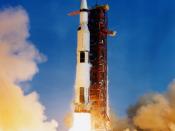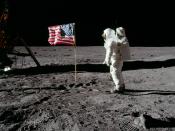Men and woman alike have always dreamed of exploring the heavens and walking on another world. For this reason, there was need for the birth of a Space Program in the 1950's. The 1950s witnessed the birth of the modern era of space exploration. A milestone in this process was the inauguration of the National Aeronautics and Space Administration NASA on October 1, 1958, as the successor to the National Advisory Committee for Aeronautics (www.NASA.gov). The latter, founded in 1915, had played a key role in the development of the nation's aeronautical industry through research and related activities. The new agency had a similar mandate and was also delegated the task of overseeing the civilian space program. NASA is the key piece of a proud history in space exploration and continues to be the leader in a new generation of space exploration.
NASA is the key link in US space exploration.
It was born in the midst of a space race between the United States and the Soviet Union. Russia had become the first nation to successfully launch an artificial satellite, Sputnik 1, on October 4, 1957, and the United States followed with Explorer 1 in January 1958 (www. NASA.gov). Russia soon reached another plateau in its program and initiated the era of manned space flight on April 12, 1961, when Yuri Gagarin became the first human in space during a one-orbit mission (www.ucdavis.edu/book/history/advanced/program-01.html). The U.S. operated program, at that time, centered about Project Mercury and its seven astronauts. On May 5, 1961, Alan Shepard became the first American in space during a fifteen-minute sub orbital flight, and John Glenn made the first orbital flight nine months later (www. NASA.gov). While the six manned Mercury missions provided NASA with invaluable experience, Project Gemini, its successor, was a bridge to...


